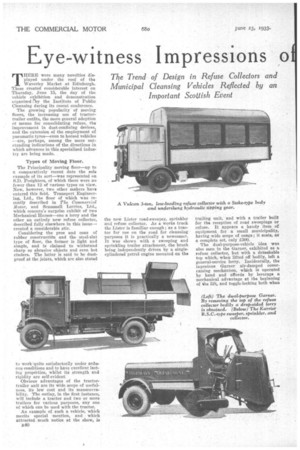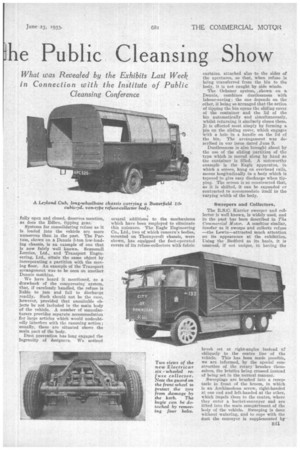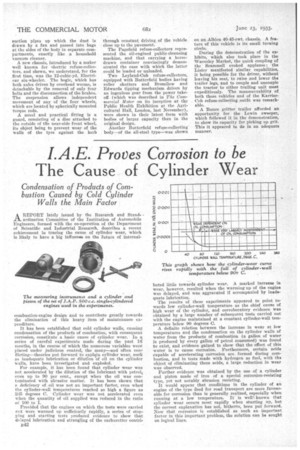THE COMMERCIAL MOTOR 6S0 June 2 3 1 933
Page 54

Page 55

Page 56

If you've noticed an error in this article please click here to report it so we can fix it.
Eyewitness Impressions ol :he Public Cleansing Show
THERE were many novelties displayed under the roof of the Waverley Market at Edinburgh. These created considerable interest on Thursday, June 15, the day of the vehicle exhibition and demonstration organized by the Institute of Public Cleansing during its recent conference.
The growing popularity of moving floors, the increasing use of tractortrailer outfits, the more general adoption et means for consolidating refuse, the improvement in dust-confining devices, and the extension of the employment of pneumatic tyres--even to horsed vehicles —are, perhaps, among the more outstanding indications of the directions in which advances in this specialized industry are being made.
Types of Moving Floor.
The Principality moving floor—up to a comparatively recent date the sole example of its sort—was represented on S.D. Freighters, of which there were no fewer than 12 of various types on view. Now, however, two other makers have entered this field. Transport Engineering, Ltd., the floor of which was reeently described in The Commercial Motor, and Seammell Lorries, Ltd., which concern's surprise exhibit of two Mechanical Horses—one a lorry and the other an entirely new refuse collector, described fully elsewhere in this issue— created a considerable stir.
Considering the pros and cons of rubber construction and the steel-slat type of floor, the former is light and simple, and is claimed to withstand sharp or abrasive objects and even hot cinders. The latter is said to be dustproof at the joints, which are also stated to work 'quite satisfactorily under arduous conditions and to have excellent lasting properties, whilst its strength and rigidity are self-evident Obvious advantages of the tractortrailer unit are its wide scope of usefulness, its low cost and its manceuvrability. The outlay, in the first instance, will include a tractor and two or more trailers for various purposes, any one of which can be used with the tractor.
An example of such a vehicle, which merits special mention, and which attracted, much notice at the show, is
B40
the new Lister road-sweeper, sprinkler and refuse collector. As a Works truck the Lister is familiar enough ; as a tractor for use on the road for cleansing -purposes it is practically a newcomer. It was shown with a sweeping and sprinkling trailer attachment, the brush being independently driven by a singlecylindered petrol engine mounted on the trailing unit, and with a trailer built for the reception of road sweepings or refuse. It appears a handy item of equipment for a small municipality, having wide scope of usage; it costs, as a complete set, only .£300. The dual-purpose-vehicle idea was also seen in the Garner, exhibited as a refuse collector, but with a detachable top which, when lifted off bodily, left a general-service lorry. Incidentally, the ingenious Garner air-damped coverraising mechanism, which is operated by band and affords by leverage a mechanical advantage at the beginning of the lift, and toggle-locking both when
fully open and closed, deserves mention, as does the Edbro. tipping gear.
Systems for consolidating refuse as it is loaded into the vehicle are more numerous than in the past. The rectum, shown on a Dennis 3-ton low-loading chassis, is an example of one that is now fairly well known. Scanamell Lorries, Ltd., and Transport Engineering, Ltd., attain the same object by incorporating a partition with the moving floor. An example of the Transport arrangement was to be seen on another Dennis machine.
We have heard it mentioned, as a drawback of the compressing system, that, if carelessly handled, the refuse is liable to jam and fail to discharge readily. Such should not be the case, however, provided that unsuitable objects be not included in the main body of the vehicle. A number of manufacturers provides separate accommodation for large articles which would undoubtedly interfere with the ramming action ; usually, these are situated above the main part of the body.
Dust prevention has long engaged the Ingenuity of designers. We noticed several addition; to the mechanisms which have been employed to eliminate this nuisance. The Eagle Engineering Co., Ltd., two of which concern's bodies, mounted on Thornycroft chassis, were shown, has equipped the foot-operated covers of its refuse-collectors with fabric curtains, attached also to the sides of the apertures, so that, when refuse is being transferred from the bin to the body, it is not caught by side winds.
The Ochsner system, „shown on a Dennis, combines dustlessness with labour-saving; the one depends on the other, it being so arranged that the action of tipping the bin opens the sliding cover of the container and the lid of the bin automatically and simultaneously, whilst returning it similarly closes them. It is effected most simply by forming a Pin on the sliding cover, which engages With a hole in a handle on the lid of the bin. The arrangement was described in our issue dated June 9.
Dustlessness is also brought about by the use of the sliding partition of the type which is moved along by hand as the container is filled. A noteworthy example is the Eagle apparatus, in which a screen, hung on overhead rails, moves longitudinally in a body which is tapered to give easy discharge when tipping. The screen is so constructed that, as it is shifted, it can be expanded or co/Art-Leta to accommodate itself to the varying width of the body.
Sweepers and Collectors.
The R.S.C. Karrier sweeper and collector is well known, is widely used, and in the past has been described in The Comntercial Motor. A machine similar, insofar as it sweeps and collects refuse —the Lewin—attracted much attention on its appearance at the exhibition. -Using the Bedford as its basis, it is unusual, if not unique, in having the
brush set at right-angles instead of obliquely to the centre line of the vehicle. This has been made possible, we are informed, by the special construction of the rotary brushes themselves, the bristles being crossed instead of being set in the normal manner.
Sweepings are brushed into a receptacle in front of the broom, in which is an Archimedean screw, right-handed at one end and left-handed at'the other, which impels them to the centre, where they enter a bucket-conveyor and are lifted into the main compartment of the body of the vehicle. Sweeping is done without watering, and to cope with the dust the conveyor is supplemented by suction pipes up which the dust is drawn by a fan and passed into bags at the sides of the body in separate compartments, exactly like a household vacuum cleaner.
A new chassis, introduced by a maker well known for electric refuse-collectors, and shown, we understand, for the first time, was the 12-cubic-yd. Electricar six-wheeler. The bogie, which has both axles driven by overhead worms, is detachable by the removal of only four bolts and the disconnection of the brakes. The suspension allows independent movement of any of the four wheels, which are located by spherically mounted torque rods.
A novel and practical fitting is a guard, consisting of a disc attached to the outside of tile near-side front wheel, its object being to prevent wear of the walls of the tyre against the kerb through constant driving of the vehicle close up to the pavement.
The Pagefield refuse-collectors represented the oil-engined public-cleansiug machine, tied that carrying a horsedrawn container convincingly demonstrated the ease with which the latter could be loaded or unloaded.
Two Leyland-Cub refuse-collectors, equipped with Butterfield bodies having roller shutters and Bromilow and Edwards tipping mechanism driven by an ingenious gear from the power takeoff (which was described in The Commercial Motor on its inception at the Public Health Exhibition at the Agricultural Hall, London, last November), were shown in their latest form with bodies of larger capacity than in the original design.
Another Butterfield refuse-collecting body—of the all-steel type—was shown on an Albion 40-45-cwt. chassis. A feature of this vehicle is its small turning circle.
During the demonstration of the exhibits, which also took place in the Waverley Market, the quick coupling of the Seammell evoked applause ; the Lister manifested similar capabilities, it being possible for the driver, without leaving his seat, to raise and lower the trailer legs, and to couple and uncouple the tractor to either trailing unit most expeditiously. The manceuvrability of both these vehicles and of the KarrierCob refuse-collecting outfit was remarkable.
A Bunco 'eritter trailer afforded an opportunity for the Lewin sweeper, which followed it in the demonstration, to show its capacity for picking up grit. This it appeared to do in an adequate manner.




























































































